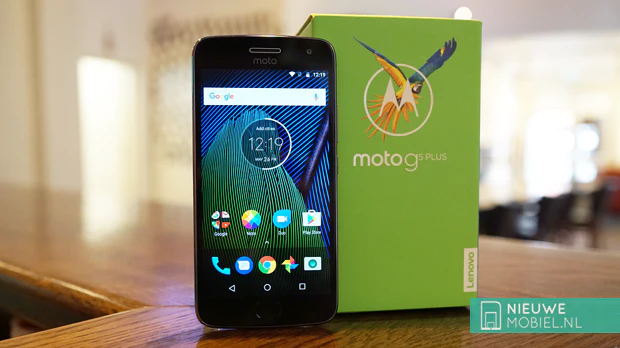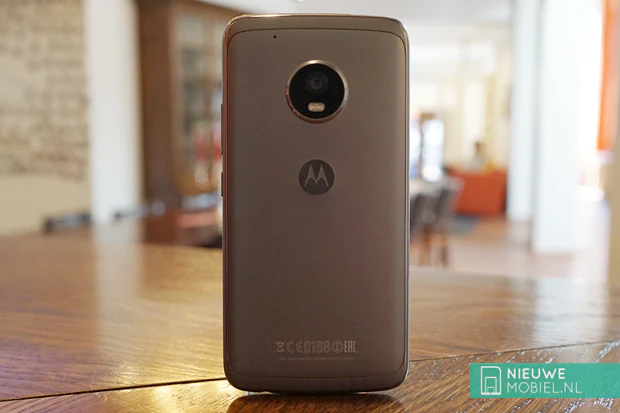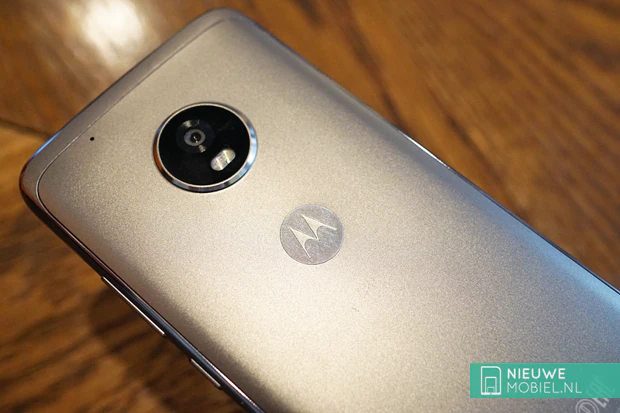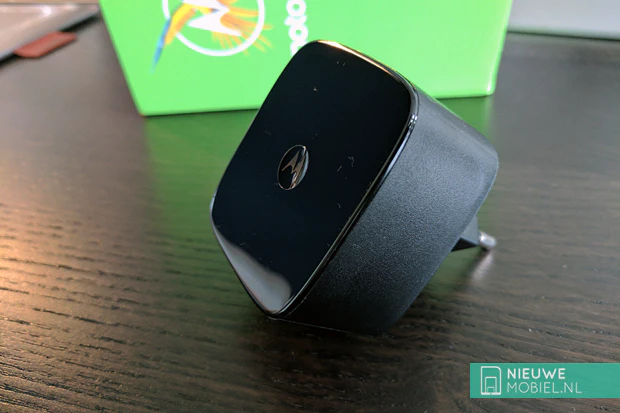Motorola Moto G5 Plus review
Is the G5 Plus model a supermodel?
The Moto G sets have been known for years for their good price/quality ratio and so it is not surprising that we are now ready for the fifth generation.

In the meantime, other manufacturers have not been idle and competition has increased significantly. Motorola tries to outsmart them by releasing two versions of G5. Of these we have challenged the G5 Plus. Motorola uses the Plus addition mainly to indicate that we are dealing with a more elaborate model, this model isn't much bigger.
Content of the box
TurboPower charger (SSW-2680EU)
MicroUSB cable (SKN6461A)
SIM lock removal tool
Quick start guide
For a long time Motorola's G-Series was known as compact designed aircraft with solid specifications. On the Moto G4 the hardware was still thick but the compactness was hard to find because of a 5.5 inch screen. For the G5, Motorola returned to a more modest format with a 5 and 5.2 inch screen for the G5 and G5 Plus respectively. Furthermore, the Plus has a 12 megapixel camera, 2.0 GHz octacore processor and fingerprint scanner.
Design
Despite its larger screen, the Plus is only half a centimetre larger than the regular G5. Yet the G5 Plus isn't really compact. This is due to the rather considerable space around the screen. This is especially the case above and below the screen. This is reflected in a screen-to-body ratio of 67.2%. Although our impression of this may be a bit distorted by the recent testing of the Samsung Galaxy S8 and LG G6. Above the screen we see a Moto-logo and a cut-out in the glass for the earpiece which also serves as a speaker. The self-image camera is located in the upper right corner. There is no notification light. Beneath the screen, the oval fingerprint scanner is slightly recessed.

The transition from the glass to the sides is not completely flat. The shiny part of the side forms a small ridge that is not quite level all around. There is also a little space between the glass and the side where dirt can collect. The sides have a slight bulge and run diagonally backwards. The buttons of the G5 Plus are on a nice spot on the right side of the device. At the top is the SIM drawer, which also has room for a second SIM and a microSD card. A headset and microUSB plug can be plugged in at the bottom.

The G5 Plus is promoted as a metal device but that is a bit more nuanced. All around it is made of plastic. This runs at the top and bottom also a bit to the back The back of the G5 Plus is also made of metal but then executed as a kind of metal cover. However, it cannot be removed and that goes for the battery as well. Between the metal and the plastic on one side is a pretty big gap. This immediately illustrates that the G5 Plus is not waterproof. Instead it remains water repellent thanks to a special coating.

At the back there is a fairly large round, black bulge with chrome-coloured edge. This is copied from the Moto Z. However, there the bulge had another function to keep additional modules in place and that is not the case on the G5 Plus. Besides the camera and double LED flash, there are also a number of sensors in this bulge. Because of its obtuse angles and convex sides, the G5 Plus lies very comfortably in the hand. Despite the fact that the camera is a bit large compared to the screen size, it is still quite easy to handle.
Performance
The battery of the G5 Plus has a capacity of 3000 mAh. Nowadays this is about the minimum for devices with significantly larger screens, so we were extra curious what this meant for the G5 Plus. After a usage time of more than 48 hours, the battery had dropped below 5% remaining capacity. When we then saw a screen on time of almost eight hours we were quite impressed. This didn't always work out, but a screen-on-time of 7 hours is quite common.



".
The G5 Plus has Android's standard battery saving feature. This limits the performance of the device, Vibrate mode, location services and most background data to extend the life of the device. It's a bit of a good thing to have it on all the time but it can also turn on automatically at 15% or 5% remaining battery charge.

Unlike its predecessors, the G5 Plus now comes with a TurboPower charger as standard. This is a rather large plug that uses Qualcomm's Quick Charge 2.0 technology. It only uses the maximum charging power in the beginning. If the battery is charged for about 20% after a quarter of an hour, it switches back to less power. This should improve the condition of the battery and make it last longer.


".
The G5 Plus is equipped with a more powerful processor than its smaller brother. This one performs stably and in combination with 3 GB of working memory it turned out to be very good in practice. Apps start up quickly and run effortlessly side by side.
Screen
The screen has a resolution of 1920 × 1080 pixels. Between all the contemporary pixel violence, such a resolution on a 5.2 inch screen will certainly not save you a mud figure. Detail reproduction is fine and colors are sparkling. This is mainly because the IPS screen gives a nice clear image and white is really white. Despite the fact that this is not an AMOLED screen with possibly somewhat excessive color reproduction, the color mode can be changed. You have the choice between standard and vivid. By the way, it is standard on vivid.



".
Motorola devices have long had an always on screen function when the device is locked. The information and notifications shown are very useful. In order for the LCD screen not always to be fully on, the information is only displayed when a message arrives or when you pick up the camera. Oddly enough, this function cannot be set in the settings but you need to be in the Moto application.
Software
The beauty of Moto devices is that they run on an almost pure version of Android. The manufacturer hardly adds any modifications of their own and therefore phones can be quickly updated. Nevertheless, the G5 Plus runs on Android 7.0 and not the latest version 7.1.2. This does not directly affect the appearance of the interface, but it does ensure that you cannot use special application shortcuts. With pure Android, as few apps as possible are installed by default and the number of additional apps is limited to two. So you can decide for the most part which apps you want to have installed.



".
The launcher has been slightly modified by Motorola and is now a kind of in-between of the two Android launchers on the Nexus and Pixel devices. Even though it resembles the Pixels the most. There is no special button to open the app menu. Instead, you have to drag up the bottom line of the launch screen, where there's room for five shortcuts.



".
The menu has a black background with four icons per line. At the top is a line with four changing app icons. These seem to be apps that are used a lot but for which there is no shortcut on a home screen. Contrary to standard Android, this cannot be turned off.
The functionality of the always-on display has been extended and brightened up a little further. Below the clock are icons of apps for which notifications have been received. When a new notification is received, the icon of the app is enlarged with a preview of the content underneath. With a gradually disappearing circle around it, it is extra illustrated how full the battery is.



".
In the Moto-app you can find some additional functions for operating the device. For example, you can shake the flashlight twice to turn it on, turn your wrist twice to start the camera and put the camera on the table with the screen to turn on the 'don't disturb' function.
Hardware
Motorola started quite late with their aircraft with a fingerprint scanner, but in the meantime the technology has also penetrated to the G models in the mid-range segment. The oval scanner underneath the screen has a considerable size and is easy to use by touch. The sensor is fast and not too picky when recognizing a fingerprint. Even a partial cover won't upset the scanner. A short vibration signal indicates that the device is unlocked.



".
The fingerprint scanner can also be used to operate the device. It can be turned on in the Moto-app and makes the virtual control keys disappear from view. By swiping the sensor you can go back to a previous window or open the overview of recent apps. A short tap takes you back to the home screen. The device can also be locked again by covering the fingerprint scanner with a finger for a little longer. This finger doesn't need to be saved. This works really well, so you hardly need the power button anymore. What's more, the loss of the virtual control buttons gives you more screen for it.


Unlike its smaller brother, the G5 Plus does have an NFC sensor at its disposal.
Camera
Compared to its predecessor and also its little brother, the camera of the Plus has to do remarkably well with less megapixels, namely 12. Still, the term 'plus' does apply to the camera because it has larger pixels and a larger aperture of f/1.7. This allows the sensor to capture more light and less noise should be visible in the evening.


Motorola's camera interface has long been characterized by extreme simplicity. In fact, it was so bare that it got in the way of ease of use. In the meantime this has been greatly improved and the interface resembles the commonly used standard again. The HDR function can be set to automatic.


To switch to video, open a drop-down menu in the right-hand corner. Here you also have the choice between panorama, slow motion and professional photo mode. The G5 Plus can simply record video in 4K at 30 frames per second. Slow motion in 720p with 120fps. In professional mode, focus, white balance, shutter speed, ISO and brightness can be adjusted.


Zooming is done by dragging from bottom to top across the screen. Settings can be dragged from the left into the image and the gallery opens with a movement in the opposite direction. The self-image camera is unchanged and stays at 5 megapixels. A manual or automatic beauty filter is available for operation.
A short comparison showed that especially detail and contrast reproduction of the camera in the Plus is a lot better than with the regular G5. In low light conditions, the capacity to capture extra light is not always noticeable and, just like when filming, the lack of optical image stabilization can be a bit of a problem. For a camera in this price range, however, the G5 Plus is not immediately very heavy to charge. In daylight, the results are very neat across the board with good color reproduction and exposure.
Conclusion
By now the price of a G5 Plus has dropped close to 250 euros. That's a kind of psychological barrier, and nowadays it's not unimportant in the context of BKR registration with a subscription. However, the fact that the G5 Plus is affordably priced is hardly noticeable in daily practice. On the outside you can see it on the finish which could be a bit tighter but the device feels solid. In relation to the screen size, the G5 Plus is quite large but this does not stand in the way of the daily ease of use. Partly helped by an excellent display and endurance and hardware on which pure Android runs smoothly.
Although the G5 Plus camera does not have optical image stabilization, and perhaps more should be expected based on what Samsung got out of it in the Galaxy S7, it is nevertheless one of the best, if not the best, in this price range.

